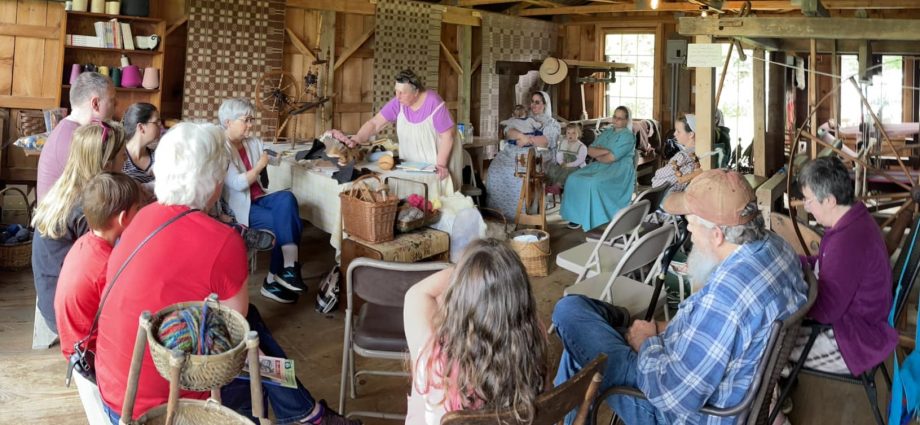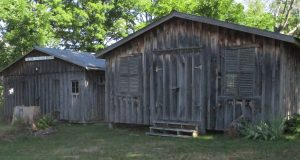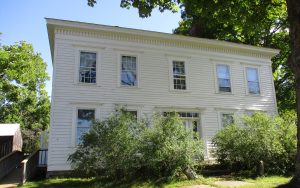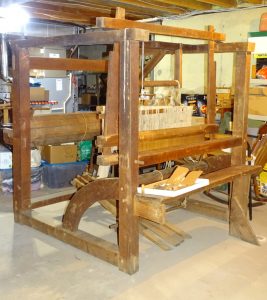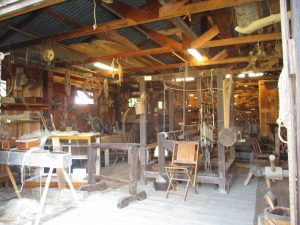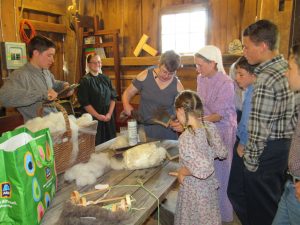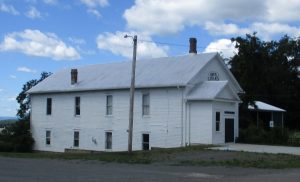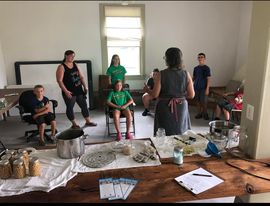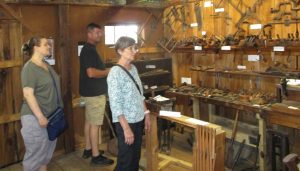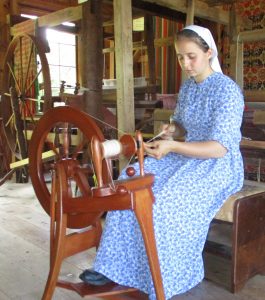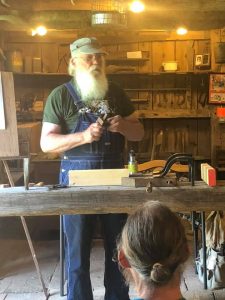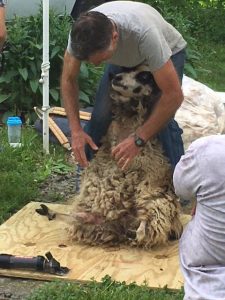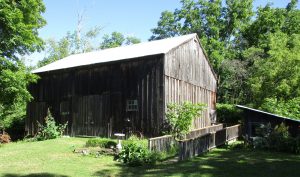Visitors to the Home Textile Tool Museum in Orwell can learn a wide variety of homesteading skills such as looming from veteran artisans. The venue’s final open house event for the season will be held on Saturday, Sept. 24.
Story and some photos by Rick Hiduk / Additional photos courtesy HTTM
(Originally published in Living Bradford County Magazine)
It’s easy to take clothing for granted when there are so many places to purchase garments. And even those who enjoy making clothing at home can find bolts of material fairly easily. Two hundred years ago, however, not even fabric would have been possible without the everyday process of turning plant and animal fibers into cloth that could then be made into clothing.
“Every piece of fabric is either woven, knitted, or felted, even if by modern machines,” said Michelle Kaleta of Rome, who serves as a board member and instructor for the Home Textile Tool Museum (HTTM) in Orwell Township. “Few people understand the intense amount of labor that it took to make fabric.”
The Home Textile Tool Museum offers much more than old-time tools, though there are literally thousands of them on display. The HTTM has become home to a growing number of artisans and homesteaders who enjoy sharing their knowledge of traditional skills and ways of living with visitors from near and far. While every township in Bradford County has some claim to fame, it’s quite fitting that the museum would be situated on Orwell Hill Road.
According to background information posted on the museum’s website, 134 families lived in Orwell in 1810, two years before the final formation of Bradford County from parts of Lycoming and Luzerne counties. Almost every one of them owned two spinning wheels – one for wool and one for flax. One in four families also owned a loom, used primarily for the making of their own clothing.
The HTTM is set up to replicate a typical country home of that era, with a federal style house (above), English-style threshing barn, tool building and workshop, a chicken coop, wood shed and gardens. Dozens of wheels and looms, distinctive to their cultural origins, are on display. Many, like the Chaffee loom (below), were donated by local families, the Chaffees being from nearby Rome.
The idea for the museum was conceived in 1997 by then property owners Bill and Vicky Ralph, who had moved from Long Island, NY, to Orwell Township in 1972 to take up homesteading, a lifestyle of self-sufficiency. They didn’t even have running water on the property for the first few years that they lived there.
“Vicky was a spinner and a weaver. She did all kinds of textile arts and raised Angora rabbits for their fur,” said HTTM board member Margaret Boritz of Smithfield Township. “Unlike sheering a sheep, when an Angora rabbit is ready to molt, its coat starts to detach naturally.”
“Vicki had a spinning wheel and would appear at different festivals and spin from her rabbits,” added board member Joy McCracken. “It was always a crowd-pleaser.”
Traditionally, owner and rabbit have a very relaxing experience as the animal is slowly rotated and the fur is gently pulled off – a process known by many as “spinning the bunny.” The fur is literally spun into thread on a small wheel sitting nearby.
Bill was a writer and an experienced machinist. He built a lathe so he could make repairs to his and Vicky’s growing collection of wheels and looms, as well as those of nearby textile makers. He acquired quite a following east of the Mississippi River and eventually around the world. “It became a second career for him, repairing more than a thousand wheels in his lifetime,” said Boritz.
Though Bill was adamant about securing his collection and his workshop, he was also prone to throwing the doors open to attract passersby. “Bill loved for people to visit and learn from him, and he enjoyed learning about them too,” Boritz related. “Guests were encouraged to pick up a project or just watch others hone their skills. He was very interested in this becoming a place where people could be hands-on.”
In 2000, the museum opened as a showcase for Bill’s collection of tools and Vicky’s wheels and looms. Traditional textile artisans found out about the endeavor via the internet and often became regular visitors, volunteers, and presenters. In addition to the arts of both animal and plant textiles, the HTTM began offering homesteading classes, and Homesteading Day is held annually in honor of the Ralphs.
The pandemic opened up the HTTM to a new audience. “During Covid, people wanted to learn more about how they could take care of themselves.” People were buying pressure cookers and hundreds of canning jars, but few of them knew precisely what they were doing. So attendance to the museum and participation in its programs skyrocketed. Some visitors came looking for information on food preservation but left wanting to know more about how to make fabric, crochet, knit, and embroider. According to McCracken, the board members are very active in the running of the museum. Pat Hilt, a founding member of the museum, is considered a “complex weaver,” utilizing a single-frame loom to give demonstrations. There are approximately 20 other textile experts and retired professionals who share their knowledge and skills with visitors. Original board member, Pat Hilts, who was born in Rome and now resides in Wisconsin, serves as curator, visiting several times per year on extended vacations to work at the museum.
Early on, the Ralphs found a partner in Michael Holcomb, a former administrator at Rutgers University from New Hope who bought property in Orwell Township, including the former Orwell Grange building that he liked to fill with local antiques.
“After awhile, Michael married and moved back to New Hope,” noted McCracken. “We purchased the Grange (below) in 2015, and he gifted us with much of his magnificent collection of textile tools.”
Extensive and ongoing renovations since then have restored the acquired structure to its original purpose as a learning center for textiles, homesteading and household economics. In addition to modern necessities like 200 amp electrical service, heating, and an accessible ramp to the classroom level of the building, the HTTM conducts a variety of programs and workshops there, many of them free to the public. “We’re putting together a show next year to highlight the Holcomb collection,” said McCracken.
Associates of the HTTM agree that perceptions of textile making and the homesteading life are greatly altered for first time visitors to the museum.
“Their expectations are not what is actually here,” Kaleta offered. “They become quite astonished at learning how much went into making basic textiles and leave with a greater appreciation of what the textiles are all about.”
McCracken related that the HTTM makes a great effort to attract youths, including school students for tours and demonstrations. “I think they’re expecting a romantic fairy tale history, and they are truly impressed with the skills and the knowledge and the amount of labor that goes into making and using textiles,” she said of the affect the museum has on children of all ages. “It’s a very positive thing. Their eyes are opened wide in a light bulb moment. Instead of learning about the ‘good old days,’ they are learning about the ‘real’ old days.”
Early guests on a warm Saturday in July were impressed by the scope of the exhibits. “They have a huge display of artifacts that are well-preserved,” Carol Battaglini (below, right) of Endicott, NY, who is a fan of the resurgent interest in textiles. Her husband, Chris (below, left), loved the collection of tools, especially the axes. “It’s amazing to imagine swinging those things,” he remarked.
The regular season for the Home Textile Tool Museum is from March through August with the main buildings open from 10 am to 4 pm on Saturdays, but special tours for groups are available through mid October. On Saturday, Sept. 24, the final public event of the year, called the Fiber Frolic, will feature crafts persons of all kinds from guilds across the region. In addition to demonstrations and guided tours of the venue, vendors will offer a “destash sale,” a traditional way among textilers of clearing out overstocked inventory of tools and other supplies before heading into winter.
For this and all other special events, interested readers are encouraged to follow The Home Textile Tool Museum on Facebook or log on to www.httm.org. The schedule for 2023 events is expected to be posted in December.
First-year volunteer docent Mikhaela Brister of Rome Township is one of nine siblings in a self-described simple farm family that has always made their own clothing. She looks forward to sharing her knowledge of textiles as she continues to learn from board members
Woodworker Dick Warner provides a demonstration to museum guests.
Marck Hudyncia sheers a sheep for wool that will be carded, cleaned and spun into yarn before being knitted or loomed into fabric.
